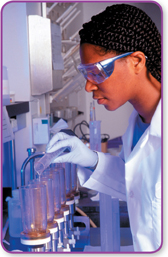Safety Scientists working in a laboratory or in the field are trained to use safe procedures when carrying out investigations. Laboratory work may involve flames or heating elements, electricity, chemicals, hot liquids, sharp instruments, and breakable glassware. Laboratory work and fieldwork may involve contact with living or dead organisms—not just potentially poisonous plants and venomous animals but also disease-carrying mosquitoes and water contaminated with dangerous microorganisms.
Whenever you work in your biology laboratory, you must follow safe practices as well. Careful preparation is the key to staying safe during scientific activities. Before performing any activity in this course, study the safety rules in Appendix B. Before you start each activity, read all the steps and make sure that you understand the entire procedure, including any safety precautions.
The single most important safety rule is to always follow your teacher's instructions and directions in this textbook. Any time you are in doubt about any part of an activity, ask your teacher for an explanation. And because you may come in contact with organisms you cannot see, it is essential that you wash your hands thoroughly after every scientific activity. Remember that you are responsible for your own safety and that of your teacher and classmates. If you are handling live animals, you are responsible for their safety too.

FIGURE 1–16 Science Safety Wearing appropriate protective gear is important while working in a laboratory.
1.3 Assessment

-
Review List the characteristics that define life.
Applying Concepts Suppose you feel hungry, so you reach for a plum you see in a fruit bowl. Explain how both external and internal stimuli are involved in your action.
-
Review What are the themes in biology that come up again and again?
Predict Suppose you discover a new organism. What would you expect to see if you studied it under a microscope?
-
Review At what levels do biologists study life?
Classify A researcher studies why frogs are disappearing in the wild. What field of biology does the research fall into?
-
Review Why do scientists use a common system of measurement?
Relate Cause and Effect Suppose two scientists are trying to perform an experiment that involves dangerous chemicals. How might their safety be affected by not using a common measurement?
PRACTICE PROBLEM
In an experiment, you need 250 grams of potting soil for each of 10 plant samples. How many kilograms of soil in total do you need?


Table of Contents
- Formulas and Equations
- Applying Formulas and Equations
- Mean, Median, and Mode
- Estimation
- Using Measurements in Calculations
- Effects of Measurement Errors
- Accuracy
- Precision
- Comparing Accuracy and Precision
- Significant Figures
- Calculating With Significant Figures
- Scientific Notation
- Calculating With Scientific Notation
- Dimensional Analysis
- Applying Dimensional Analysis




